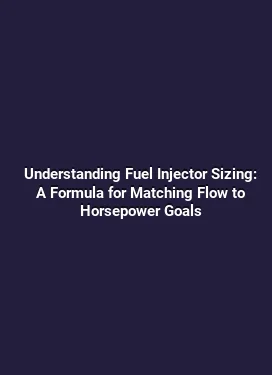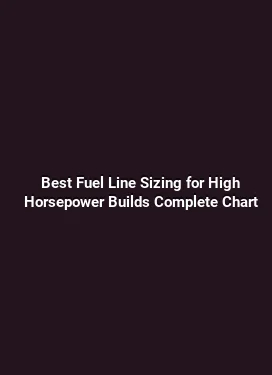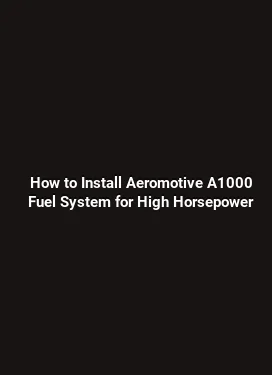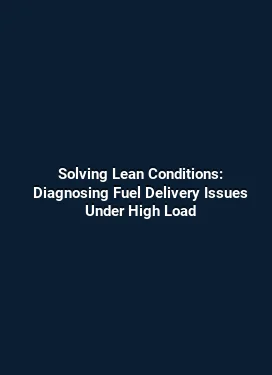Performance Intake Manifolds: Plastic vs. Aluminum and Variable Geometry Design
Understanding Intake Manifold Fundamentals

Intake manifolds play a pivotal role in delivering the air that fuels combustion. The primary job is to evenly distribute the air entering the cylinders while preserving a favorable pressure profile across the intake runners. This distribution is not just about volume; it also involves minimizing pulsating flow, reducing inertial losses, and maintaining a stable charge in the plenum. The geometry of the manifold, including runner length, plenum volume, and overall pathing, directly influences throttle response, low-end torque, and peak horsepower. As engines evolved to operate at higher RPMs and with tighter emission constraints, manifolds began to incorporate more sophisticated air-handling characteristics, such as tuned runner lengths and pressure wave reflections that optimize charging efficiency at specific engine speeds.
Two foundational concepts shape manifold performance: flow impedance and thermal management. Flow impedance relates to how easily air can traverse the manifold from the throttle body into each cylinder. Factors such as runner diameter, cross-sectional area changes, and surface finish contribute to frictional losses and boundary layer effects. Thermal management is equally critical because air density decreases with temperature. Warmer intake air reduces oxygen density, which can lower volumetric efficiency. Consequently, many designs aim to manage heat transfer from the engine to the incoming air to preserve density while avoiding excessive cooling that could negatively affect fuel atomization and combustion stability.
Material Choices: Plastic vs. Aluminum
Material selection for intake manifolds hinges on a blend of cost, weight, thermal behavior, and manufacturing practicality. Historically, aluminum has been favored for performance-oriented applications due to its rigidity, high thermal conductivity, and resistance to creep under load. Aluminum manifolds often provide predictable mechanical behavior under strong acceleration, where consistent runner alignment and plenum integrity support repeatable airflow characteristics. In performance-focused builds, aluminum also benefits from robust heat dissipation, which can help mitigate heat soak during sustained high-RPM operation.
Plastic, including reinforced polymers and composite materials, has surged in popularity for mass-market and performance-enhanced applications alike. Modern plastics offer significant weight savings, which translates to reduced rotating mass and improved throttle response. They also allow complex, integrated geometries through molding processes, enabling shorter lead times and more compact packaging. A well-engineered plastic manifold can exhibit excellent dimensional stability, with ribbing and internal features designed to minimize wall thickness without sacrificing strength. Thermal behavior in plastic manifolds is a nuanced topic: while plastics don’t conduct heat as readily as metal, they can be more susceptible to heat soak if shielded poorly. Designers counter this with internal insulation, targeted cooling passages, or strategic mounting that minimizes heat transfer from the engine to the air stream.
Thermal Management and Pressure Dynamics

The interaction between material properties and thermal behavior becomes most evident when assessing charge density and pressure waves inside the manifold. In aluminum designs, high thermal conductivity can promote heat transfer to the incoming air, slightly reducing air density but sometimes stabilizing the temperature gradient during rapid throttle changes. Plastic manifolds, with lower thermal conductivity, can maintain cooler intake air more effectively in certain configurations, aiding density at a given engine temperature. However, plastics require careful sealing strategies and sometimes feature lugs, gaskets, and mounts that resist heat-induced deformation. From a pressure-dynamics perspective, the manifold’s stiffness influences how it responds to pressure waves generated by intake valves closing and opening. A stiffer, well-supported structure minimizes unwanted vibrations and maintains consistent runner resonance characteristics, which is particularly important in naturally aspirated engines running at high rpm.
Variable Geometry and Plenum Tuning
Variable geometry designs introduce mechanical elements that alter the effective runner length or plenum volume in response to engine speed and load. This adaptability helps optimize the air charge across a broader RPM range, improving both low-end torque and high-end power. In practice, variable geometry can take several forms, including adjustable runner manifolds, plenum volume modulation, and even active flow control elements such as electronically actuated valves that redirect air paths. The core principle is to shift the acoustic and impedance characteristics of the inlet system in concert with the engine’s breathing demands. For sporty or performance-tuned engines, variable geometry often yields a noticeable improvement in throttle response and mid-range torque, where a static design might fall short. It’s important to acknowledge that variable geometry adds mechanical complexity, potential maintenance considerations, and a slightly higher cost envelope. However, the payoff in driveability and peak power can be compelling for enthusiasts seeking broad performance across gears and RPM bands.
Applications in Modern Engines
Modern performance engines frequently blend material choices with variable geometry to achieve a wider operating window. In high-revving engines, a plastic plenum paired with carefully engineered runner geometry can deliver rapid throttle response and reduced inertia in the intake tract. Conversely, aluminum runners may be favored for their rigidity in applications where precise impedance matching is essential under aggressive driving. In turbocharged or high-boost setups, the combination of material selection and geometry must consider boosted air density, compressor maps, and intercooling strategies. The result is a carefully tuned balance between heat management, friction losses, and wave dynamics that supports consistent performance from idle to redline.
Practical Implications for Performance and Efficiency
For everyday enthusiasts and competitive racers alike, the manifold choice translates into tangible outcomes beyond theoretical efficiency. Throttle response can feel crisper with lighter plastics when paired with optimized runner lengths and low-friction seals. In endurance-oriented builds, aluminum manifolds may offer durability under harsh conditions, but with the right plastic formulation and protective coatings, plastics can deliver comparable longevity when properly designed. Efficiency gains stem from improved volumetric efficiency, which reduces pumping losses and allows the engine to breathe more freely at target RPMs. This, in turn, can support better fuel economy during steady cruising and more confident acceleration in sport modes. A critical aspect often overlooked is maintenance: gasket integrity, mounting hardware wear, and sensor compatibility all influence long-term performance stability. Smart integration includes using materials with compatible thermal expansion properties and employing robust seal designs to prevent air leaks that degrade performance.
Cost, Durability, and Maintenance Considerations
Cost dynamics play a significant role in manifold selection. Plastic manifolds typically reduce upfront costs due to lighter materials and simpler manufacturing, which can be particularly appealing for mass-market vehicles or projects aiming for weight reduction without a large price penalty. Aluminum manifolds generally carry higher material and machining costs but may yield advantages in extreme environments or applications demanding exceptional structural integrity. Maintenance considerations should include inspecting for cracks, gasket integrity, and sensor mounting stability. In high-performance applications, frequent checks of throttle body alignment, vacuum lines, and sealing interfaces help sustain performance benefits over longer service intervals. Finally, compatibility with fuel system components—such as fuel rails, injectors, and sensors—is essential to ensure a reliable and repeatable upgrade path.
Design Trends and Emerging Technologies
Trends in intake manifold design reflect a broader push toward lightweight components, integrated sensing, and modular tuning strategies. One notable direction is the continued refinement of computer-aided flow simulations that enable precise prediction of pressure waves and flow separation. These tools help engineers tailor runner radii, plenum shapes, and transition zones to minimize turbulence and maximize charge stability. Advances in polymer science are enabling plastics with higher heat resistance, better mechanical strength, and lower creep under load, broadening the performance envelope for plastic manifolds. In parallel, additive manufacturing is opening possibilities for highly intricate internal geometries that were previously impractical with traditional casting or molding. The resulting manifolds can feature optimized internal channels that reduce flow losses while maintaining compact packaging. Lightweighting remains a consistent goal, with careful attention paid to balance between stiffness, vibration damping, and thermal performance. The practical outcome for builders is more options to tailor the intake tract to specific engines, fuels, and driving styles without compromising reliability.
Additive Manufacturing and Lightweighting
Additive manufacturing enables rapid prototyping and the production of complex internal passages that enhance flow uniformity. For performance engines, even small improvements in runner smoothness can reduce turbulence and promote more uniform air distribution across cylinders. Lightweighting strategies emphasize not only the manifold itself but the surrounding ancillary components, including throttle bodies, sensors, and mounting brackets. The cumulative effect is a chassis or engine bay with reduced inertia, improved throttle response, and potentially better fuel economy under certain operating conditions. Yet, designers must account for manufacturing tolerances, material anisotropy, and long-term durability when selecting additive-formed manifolds for daily use or competition. Practical testing remains essential to validate simulation predictions under real-world driving scenarios.
Choosing the Right Manifold for Your Vehicle
The decision matrix for selecting a manifold involves several overlapping considerations: engine displacement, boost level, intended use (street, track, or mixed), and the vehicle’s cooling strategy. For naturally aspirated engines prioritizing broad, usable torque, a manifold with tuned runner lengths and a well-designed plenum can offer substantial gains without the complexity of variable geometry. For turbocharged builds that operate across a wide rpm range, a calibrated variable geometry manifold can maintain strong low-end response while preserving high-end breathing. Weather and climate conditions also play a role: in hotter environments, air density is lower, making thermal management and air charge density even more critical. Compatibility with fuel system components, sensors, and engine control strategies is essential to ensure that the manifold delivers consistent performance across multiple conditions. Finally, the decision should factor in maintenance philosophy and ownership experience. A robust, well-integrated design may yield more reliable performance over time, reducing the need for frequent tune-ups and part replacements.






